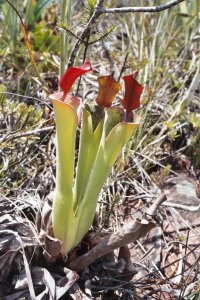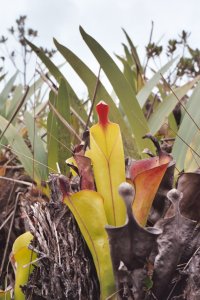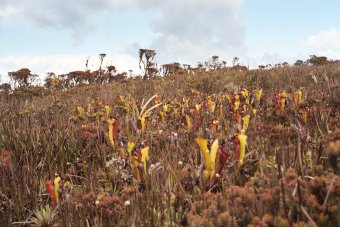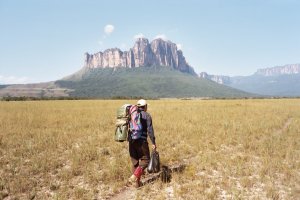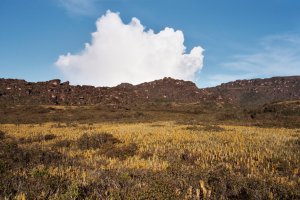The Lost World, Searching for Carnivorous Plants in Venezuela
Reprinted from the Journal Trifid No. 3/2005:
GERT HOOGENSTRIJD 1)
The genus Heliamphora belong the oldest and most simple carnivorous plants. They are found with Genlisea, Drosera, and Utricularia in South America where they grow in areas such as sabana’s, mountains and specially at table Mountains. The presentation will show a summary of various expedition to the Gran Sabana area, western sabana’s of Venezuela and table mountains like Duida, Roraima, Ilu, Tramen, Wei and Huachamacare These enormously tall table mountains often have very steep rock walls up to 3000 metres high.
They form a strong contrast with the tropical Amazon forest underneath. The local inhabitants named them Tepuis ‘Houses of the Gods’. These mountains are left over from the Stone Age and every mountain has its own unique and particular flora and fauna. The species such as the Heliamphora heterodoxa, H. ionasi, H. tatei, H. minor en H. nutans occur only in these mountains. Here they grow in little swamps or in between other plants. In this environment the plants enjoy a moderate temperature, a high degree of humidity and a large intensity of sunlight. Eight different species have been discovered and described thus far. Due to the inaccessibility to these areas there has not been a lot of research done yet. Due to this, it is highly possible that even more unknown species exist in this area, especially at the non-accessible slopes. All species have the same horn-like shape. The plants all have frail yellow-green or green pitchers with aces of red.
Deforestation, geographical monopolization of land for agricultural use, more roads, urbanization, pollution, global warming and drought are just a few of the reasons that carnivorous plants are threatened by or already suffer from extinction. The Venus Fly Trap and some of the American and Tropical Pitcher Plants in particular suffer from the threat of extinction. Endangered plants worldwide include the Sarracenia’s such as the white and yellow Trumpet Pitcher, the Venus Fly Trap, some Nepenthes species.
Ways to protect these fragile environments will be discussed as well as the possibilities for sustainable or eco-tourism or plant breeding systems that are income generating for local habitants.
Sometimes collecting of plants in the wild by individuals can form a real threat to a species. This is mainly the case concerning a few very rare and spectacular tropical carnivorous plants. These plants have a limited way in which their seeds are spread and taking away these plants or their seeds will threaten their existence. A good example from a couple of years ago is that of the largest tropical pitcher plant, Nepenthes rajah. This collector’s dream has a pitcher catcher with an eighteen-centimetre diameter. This highly rare plant can sell for hundreds of euros. Even the moderate enthusiast was prepared to pay a high price for this plant. Luckily the plant is now cultivated from tissue culture. Now any enthusiast can purchase one for a reasonable price. For the well-intended plant collector who does not want to inflict any damage on nature there are, in short, choices enough to choose from thanks to tissue culture.
The fascinating life cycle of carnivorous plants can also be observed from your living room. Many different species are sold all over the world however, only a small percentage of these species are sold in the Netherlands. The plants are offered year-round. The largest supply in the Netherlands is offered from March – October. Dutch nurseries comprise 1.5 million of the plants that are sold yearly to consumers around the world. For years, a wide assortment of species such as the Venus Fly Trap (Dionaea), North American and Tropical Pitcher Plant (Sarracenia and Nepenthes), Sundew (Drosera), different Butterworts (Pinguicula) and Bladderworts (Utricularia) have been cultivated. By in large, the plants are cultivated from seed or tissue culture in greenhouses that provide an optimal surrounding. Plants are also cultivated by division or transplanting. These methods are used for only a small amount of special plants such as the Bladderwort (Utricularia sandersonii, U. calycifida en U. livida), the Butterworts (Pinguicula gypsicola, P. primulifloraen en P. moranensis) as well as the Cobra Lily (Darlingtonia carlifornica).
Gert Hoogenstrijd was born in the Netherlands in 1967. He started to grow carnivorous plants when he was 16 as both a hobby and passion. For him cultivation of carnivorous plants began on the windowsill, but since the age of 18 has branched out onto his balcony and in greenhouses. He has a master’s degree in Energy and Environmental Science with specialisation in Biology. The many different places in which he has lived and worked as a energy and environmental specialist for developing countries and conducted research include countries in Asia, Africa and Latin America. In his free time, carnivorous plants often provide the inspiration to explore unbeaten paths in search of new plants, such as for instance the Table Mountains of South America. At the moment he is working as a specialist on topics as “nature and health” and “sustainable Tourism for the The Advisory Council for Research on Spatial planning, Nature and the Environment (RMNO). This council gives advice to the government of The Netherlands on research into problems in a specific sector of society. He is the author of the Carniflora booklet in both Dutch and English (http://www.extreme-plants.nl). Gert Hoogenstrijd was a board member of the Dutch Carnivorous plants group ‘Carnivora’, for 14 years.
http://www.extreme-plants.nl, info@extreme-plants.nl
